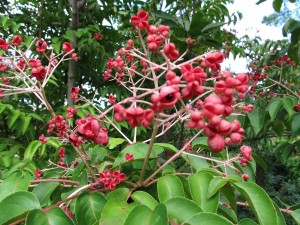The late J.C. Raulston introduced euscaphus tree (Euscaphus japonica) to gardeners in the 1980’s. Tennessee nurseryman Don Shadow is credited with naming it “Korean sweetheart tree” which has become its more popular name. It is reliably winter hardy to USDA zone 6-b.
Sweetheart tree is a small 15-20 foot tree or large shrub. The pinnately compound foliage is comprised of 7-11 leaflets which are glossy and feel thick to the touch. Leaflets hold their dark green color through the summer months. Foliage reportedly turns burgundy red in the autumn, but my tree of 20 years has finished greenish yellow every year.
A young tree branches low to the ground and its bark has a brownish purple skin with thin white lines running vertically. A 25 years and older tree exhibits a dark gray bark.
Small terminal clusters of creamy white flowers open in late May and early June. While flowers are noticeable through the compound foliage, they are not stunning compared to many showier trees and shrubs also blooming at this time.
In late summer the bright red fruits will likely capture your attention. Multiples of 1/2 inch wide, heart shaped seed capsules are grouped together, and turn cherry red in early September. The capsules open to reveal 1-3 shiny black seeds within.
Sweetheart tree grows best in a compost rich, well-drained, and moderately acidic garden soil. Grow sweetheart tree in full sun (under irrigation) or in part shade (2-3 hours sunlight and no irrigation).


 Posted in
Posted in 
